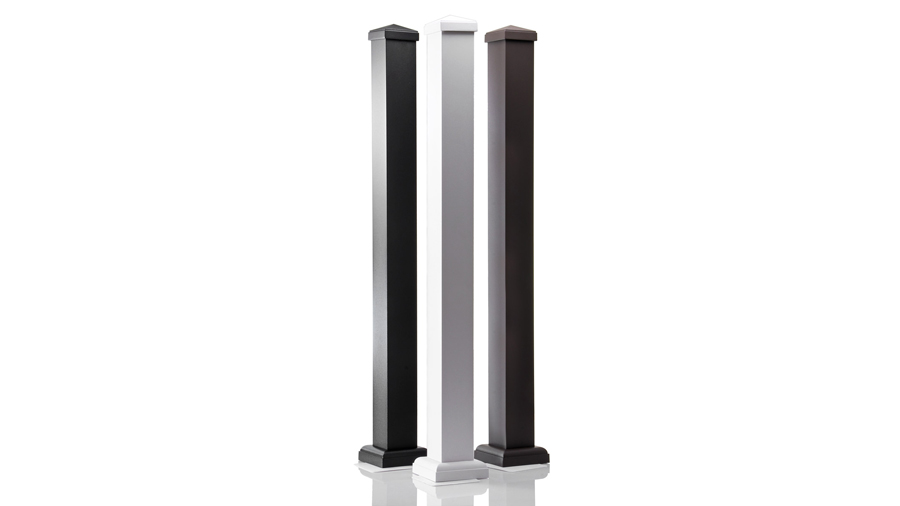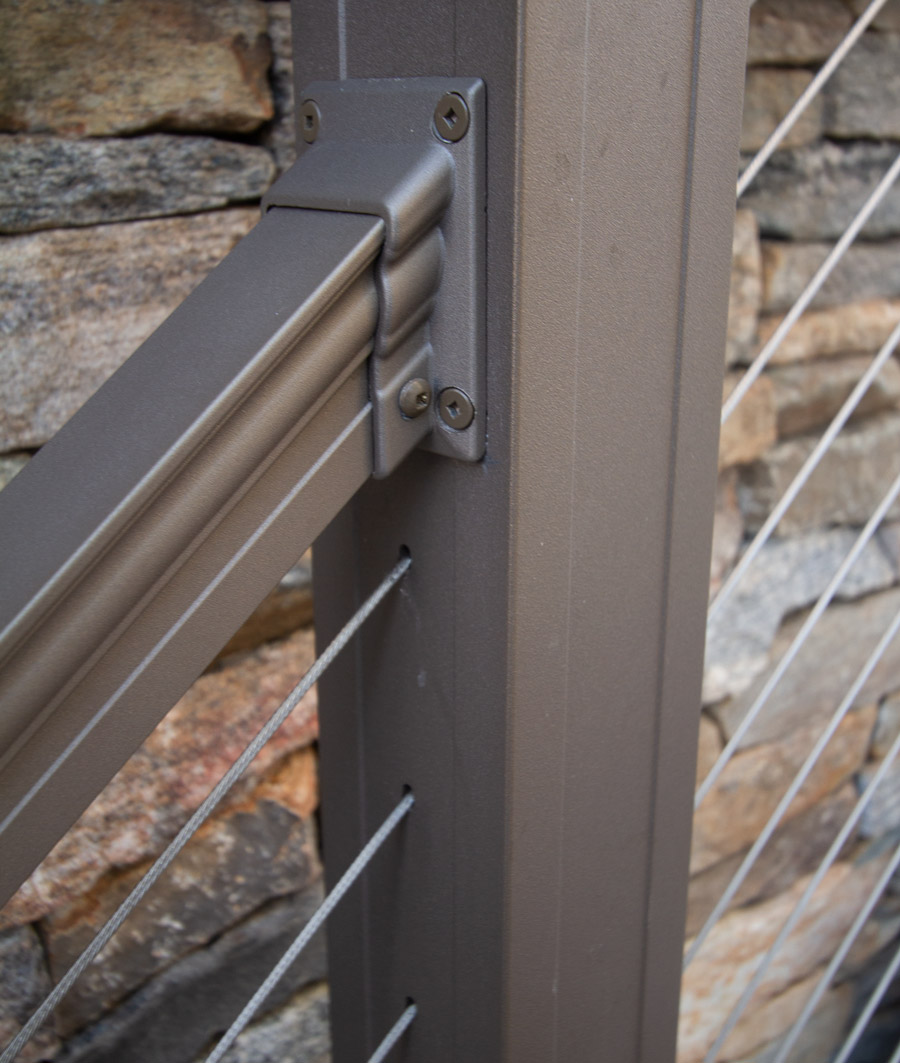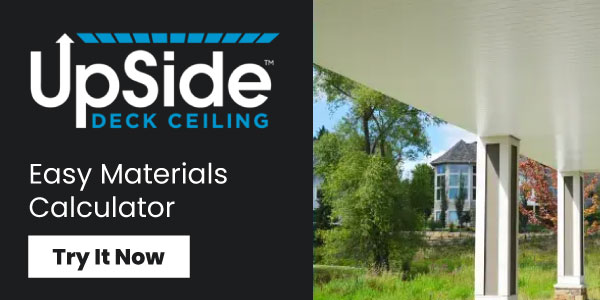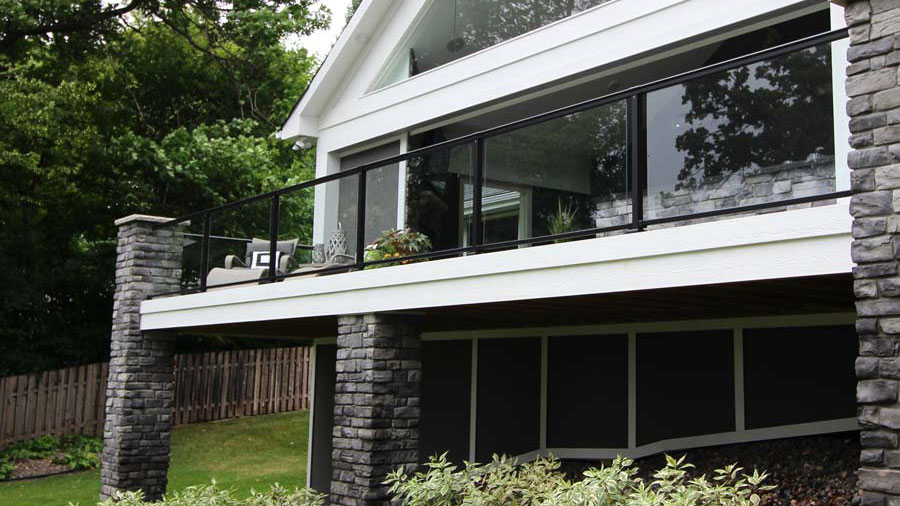Nearly Every Deck Railing Is Made Up Of The Same Basic Parts. Here's How To Plan Yours.
From sleek metal to classic composite, deck railings come in all shapes, sizes, and styles. But planning your new railing doesn't have to be an overwhelming voyage through a sea of different looks to find each individual piece you need.
In fact, nearly every deck railing is made up of the same four basic parts. Breaking down every option you see into these four categories can help you compare railings with wildly different looks to determine which railing is perfect for your deck. Let's break down each part so you can start planning your new railing today.

Basic Parts of Any Deck Railing
Anatomy of a Deck Railing
Though they look wildly different, the metal, composite, cable, and glass railings below are all made up of the same four basic components:
#1: Posts
Posts are the backbone of any railing system. They're the thick, sturdy, upright parts that get bolted directly to your deck frame.
Basic wood railings will typically use 4x4 or 6x6 pieces of lumber as posts. More modern, low-maintenance railings will often use metal posts, as shown below:

Many composite or vinyl railing systems use wood posts as the structural backbone, but cover them with post sleeves that slide over the top of the posts to improve the look of the railing and protect the structural wood from weathering over time.

Factors to consider when choosing posts:
- Height: to meet building codes, deck railing should be at least 36 inches tall. Many railings offer 36- and 42-inch options. The posts you select should be tall enough for your selected railing height.
- Note: if you have stairs, you'll need taller posts at the bottom of your stairs and in the middle of stairs.
- Width: depending on the system, posts can be slim or thick. Many systems will offer several post width options. If you like the classic look of thick, substantial posts, like most traditional wood railings, you can opt for wider posts. If you want a more modern look and less obstruction of your view, choose slimmer posts.
- Specialized post types: Some railing systems will offer specialized posts for corners or stairs, designed to save time. These posts may have brackets pre-installed, or holes pre-drilled for cables to run through.
- Color: typically, posts are offered in several different colors or finishes that can match your siding or trim, or provide a stylish contrast.
- Post trim: many posts come in complete kits that include a post cap for the top of your post and a post skirt to cover the hardware at the base of the post. If the post doesn't come with cap and skirt, you can customize the look with the cap and skirt of your choice.
#2: Rails
Rails are the long, horizontal pieces that connect one post to the next. Most railing systems will have a top rail and a bottom rail, although some systems are designed to eliminate one or the other to maximize your deck view.
Top rails come in a wide range of shapes and sizes, and give your railing its unique personality. Below, you can see the stately TimberTech Premier top rail, a more traditional look:

Often, rails will come in complete kits to make shopping easier. The AFCO Pro kit below features a top rail, bottom rail, brackets, and a foot block for support:

Factors to consider when choosing rails:
- Lengths: rails are usually sold in 6-foot or 8-foot lengths, although some shorter or longer versions do exist. Always buy a rail kit that's slightly longer than the space between your posts - rails are designed to be cut down to the exact size you need, but you can't extend a rail that's too short to span the gap.
- Shape: the shape of your top rail gives your railing its personality. Rounded-off shapes are more traditional, and functionally, they allow you to grasp them like a handrail. Flat or squared-off rails give cleaner lines for a more modern look. They can also allow you to install a deck board on top as a drink rail.
- Stairs: Most full railing systems have separate rail kits for level railing sections and angled stair sections.
- Color: like posts, rails can usually come in a range of colors. Typically, your rails should match your posts, although some composite systems allow you to mix and match colors for a contrasting look.
#3: Infill
"Infill" is an industry term that refers to everything between your posts and rails. Infill is the heart and soul of your railing system, and will carry the most importance in determining the overall look and style of a railing.
Infill is a really broad category that can include a bunch of different styles and materials. Here are some common examples. Notice how every one of these systems has the same post-and-rail structure, but with vastly different "infill" filling in the space between them:
Infill: Slim square aluminum balusters

Infill: Thicker square composite balusters
-landscape.jpg)
Infill: Stainless steel cable runs

Infill: Horizontal round balusters

Infill: Metal mesh panels

Infill: Tempered glass panels

Factors to consider when choosing infill:
- Style & look: infill can drastically change the look and feel of your railing. Most people will decide on the infill they want, then pick a railing system in that infill category
- View: if you have a deck with a showstopping view, infill is the best way to accent that view. Choose slim, minimal cable or bright, cheery glass railing if you want the least visual obstruction of your view.
- Lines: with a choice between vertical and horizontal lines, you can match the flow of your home or yard. In a setting with tall trees or vertical siding, vertical balusters or cables might fit best, while horizontal bars or cable will go great with a wide, single-story ranch home or a sweeping, wide-open deck view.
#4: Brackets
The final piece of the puzzle are brackets, the utility pieces that connect your rails to your posts.
As mentioned above, brackets often come in kits with either your posts or rails. Brackets are a simple component, but can get complicated quickly because of how many specialized options there are for different applications.
For example, these brackets are designed specifically for AFCO Pro's distinctive rounded-off top rail:

In action, the bracket is so seamless, it almost disappears into the rail itself:

Specialized brackets can help attach rails to posts at angles, like these Key-Link swivel brackets:

And stair railing sections usually have their own brackets, designed to attach the rails at a downward angle:

Factors to consider when choosing brackets:
- Angles: If you're attaching two sections of railing in a straight line or at a 90-degree angle, brackets are pretty easy - most railing systems have standard line brackets. If your deck has stairs, make sure you get compatible stair brackets, and if you have any unique angles (like a 45-degree corner cutout), you'll probably need a more specialized swivel bracket.
Planning Your New Railing
Now that you understand the four basic parts of any deck railing, you can start planning your own railing upgrade. We scour the decking industry for the best complete railing systems on the market, so our customers can easily get all their compatible parts and pieces in one place.
Browse our selection today, or give us a call at 1-888-824-5316 to speak with one of our experienced deck railing planners. Happy decking!










